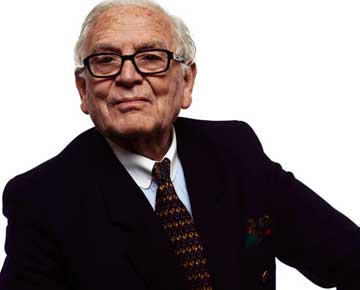Monsieur Cardin Comes to Rangoon
By Stephen Brookes in Yangon
for Asia Times
With all the brouhaha recently over Jacques Chirac's discovery of Asia (politicians, as usual, stumbling along a few steps behind the business community) the entire French fashion world has been consumed with frenzied talk of Myanmar.
Well ... maybe not consumed, exactly. And "frenzied" is a strong word. Myanmar may be a country of extraordinary beauty, but it's not exactly a place that springs to mind when the subject of haute couture comes up.
The national dress for both men and women is a sort of long skirt called a longyi, worn with a shirt and obligatory sandals. Colors tend toward the drab (brown is a popular choice), and most women wear a yellowish makeup called thanaka that has yet to take the Riviera by storm.
In fact, three decades of isolation and a disastrous "Burmese Path to Socialism" not only seriously damaged the economy -- it also didn't do much for the country's fashion sense.
But the State Law and Order Restoration Council, the military body that rules Myanmar, has been opening the country to more foreign investment and trade, and encouraging contacts with the outside world. And to that laudable end, they invited French fashion designer Pierre Cardin to come to the country for a couple of days to show off some clothes, shake a few important hands and -- who knows? -- maybe cut a deal.
So one clear morning in Yangon, two of Cardin's assistants, Edouard Saint Blice (dapper in a cream linen suit) and Maryse Gaspard (scary in pointed dark glasses and 4-inch black heels) found themselves in the dining room of the city's elegant Nawarat Hotel. Armed with cell phones and videocameras, they were there to scout models for Cardin's official show two days later, and to review the latest Myanmar fashions in a show arranged by the Ministry of Trade.
It was, more or less, what you'd expect a fashion show in a military regime to be like. One by one, the models would march out, squint into the lights and frown, while an expressionless announcer blared things like, "This is Model Number Seven, and she's looking very fashionable in a two-layered jacket, which is very fashionable at this time." And the poor girl would come charging down the runway, make sort of a where-do-I-go-now turn, frown some more, and march back again.
Cardin's assistants took in the event with Gallic aplomb, even when the announcer noted that one of the models was sporting "off-the-wall casual wear." And they were kind to the girls, some of whom were clearly encountering high heels for the first time and were having a hard time making it down the runway without toppling over. To everyone's great relief, Saint Blice and Gaspard finally had the models kick off their heels and pad up and down in bare feet -- smiling for the first time all morning.
So two days later all was in readiness, and le tout Yangon turned out to see Cardin himself and his creations. The French ambassador was there with full entourage, as well as a few anxious-looking European women, several dozen elderly male government officials (sharply dressed in white shirts and brown longyis) and a handful of Myanmar VIPs -- including Daw Khin Sandar Win, the daughter of the general who ruled the country from 1962 to 1988.
But it was an odd event, not quite fashion show, not quite press conference, in which Cardin and an advisor to the Ministry of Trade sat on stage while local reporters asked troubling questions like, "Do you think Myanmar fashion accentuates the female figure?" and "Would you like to sell longyis in France?"
Cardin fended off the questions and tooted the Cardin horn a bit, noting that he was the first fashion designer to come to Myanmar, and was grateful to be invited by the Ministry of Trade, and had traveled widely in Asia since first coming here more than three decades before, and so on and so forth.
But no one was paying much attention, because on the stage behind him, a miracle was unfolding. The plodding, dour models from a couple of days before emerged suddenly and amazingly like spectacular butterflies, dressed in fantastic swirls of yellow silk, curving blue sweeps of organza, assymetrical linen tunics worn with shocking-pink leather gloves, sharp little Parisian suits with multiple epaulets flying upward like wings, hooped wedding dresses trailing acres of lace, little hats tilted at odd angles -- it was an amazing display of female plumage, and the models were radiant, swooping delightedly around the stage as the flashbulbs popped.
At least, they looked delighted. Asked after the show how she felt about the clothes, one model smiled demurely and said, "Thank you." Did these clothes make her feel more beautiful, more graceful, more elegant? "Thank you." When an interpreter was called in, he translated the questions, listened, and replied: "She says she doesn't know. Thank you."
"Fashion is a wonderful thing for improving communication between people," Cardin said in an interview after the conference. "You can have this free exchange of ideas, of creativity, between people without thinking about nationality or religion or any of those things. And this is so important, especially where there are such different views. So I hope that someday we may have a shop here -- why not?"
Perhaps. But this was merely a goodwill visit by the French designer, and officials from the government seemed a little skeptical that the streets of Yangon would be teeming with Cardin-clad women any time soon.
"Well," said a doubtful official with the Ministry of Trade, "we're very interested in promoting the fashion industry. But when our people see these clothes, I think they'll prefer traditional dress."
Perhaps that's because fashion, by definition, implies change, and Myanmar has been isolated and unchanging for a very, very long time. Even something as simple as an unusual dress can arouse concern. Toward the end of the press conference, one stern young reporter stood with his arms folded across his chest and asked Cardin, "Do you not agree that the mode of dress reflects the moral habits of a people?"
Cardin blinked and thought for a moment (this is not the sort of question they ask in Paris, after all), and said that perhaps it reflected something entirely different.
"Fashion," he said, looking quietly at the models, "is about dreams. And what is life without dreaming?"
(Asia Times, April 29, 1996)
Welcome to Marlboro Country
By Stephen Brookes in Mandalay
for Asia Times
It was high noon, and a hot, dusty wind was blowing down the streets of Mandalay. I shook the tumbleweeds out of my spurs and had a look around: A few durian stalls, a couple of girls selling flowers, the red walls of Mandalay Palace in the distance. The usual cowboy town.
Then I spotted what I'd come for: the Texas Bar and Grill.
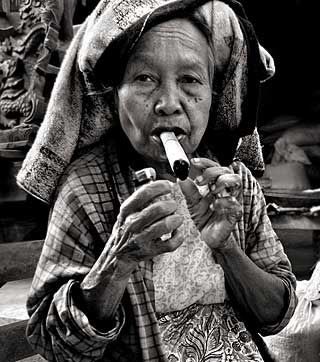
Sara HeinrichsNow, the Texas, as the cowpokes of Mandalay all agree, is the hippest place to hang in Upper Myanmar. From the longhorn skulls on the walls to the beer-keg stools, it's knee-deep in frontier fashion. There's a wagon wheel in the window and sawdust on the floor, and way too many Marlboro posters. They even have Clint Black playing on the stereo.
So it seemed like a promising place to stop in and pick up on the zeitgeist of the New Myanmar. But when I pushed open the saloon doors and looked around for some New Myanmars to talk with, there were only two -- and one was asleep under a poster that said, "Wanted: $20,000 Reward". So I ordered a Pepsi from the bartender and complimented her on her cowboy hat. She stared at me for a minute, then ran off to wake up the waiter, who brought me a menu with a huge cheeseburger on the cover.
Now, cowboy culture isn't unique to Myanmar, by a long shot. Karaoke and Wild West bars are the two great cultural plagues of modern Asia. At last count, there were more Western bars in Tokyo than in Montana. Taipei has almost a dozen of them, and Bangkok lost track a long time ago. They've clearly emerged as an indicator of cultural progress. So why not in Myanmar -- where, after 26 years of socialism, people are starting to assert their basic human right to wear goofy clothes, drink overpriced whiskey and sing along in public with Clint Black?
So to those doom-and-gloomers who claim there's no progress in Myanmar, let me note that there are now two -- count 'em, two -- Wild West bars in Myanmar. Down south in Yangon there's the Rodeo Bar and Grill, a favorite with journalists since it's just a few doors down from the Information Ministry. And after a visit to the Information Ministry -- where you sit on a hard chair while a nervous teenaged soldier guards you with an automatic rifle -- the Rodeo is a comforting place to repair to.
Besides, as an American, I felt an obligation to drop in to the Rodeo and salute the flag. But it was an odd sensation. There were all these Myanmar waiters in checked shirts and ten-gallon hats and cowboy boots, looking like they'd just ridden in from Wyoming. And then there was me -- the paleface in sneakers and khakis and a dumb shirt with a little polo player on it.
like little marlboro men"
What can I say? I'm not the Marlboro Man -- I'm an American. We're all bland and domesticated. We don't smoke anymore -- in fact, we sold all our cigarettes to Asia and spent the money on NordicTracks. We drink in moderation, if at all. We don't have weatherbeaten faces. We slather on sunblock when we go outdoors, and then we huddle under umbrellas with our dermatologists. Riding horses? Forget about it -- the animal rights people would shoot us. Besides, if we want to get somewhere, we jog.
So I felt a little out of place in the Rodeo, although the plastic log cabin walls and miniature Indian heads give it a homey feel. And the owner is a guy named Zaw Htet, who can usually be found there wearing a Guns 'n Roses t-shirt and singing a passable whiskey-voiced blues.
I like Zaw Htet, because when I asked him why he'd opened a cowboy bar in one of the most distinctly Asian countries on earth, he said, "Well, I have a degree in philosophy from Yangon University," and just left it at that.
But the thing is, Myanmar really is Marlboro Country. It has the wide open spaces, the rough edge, the emphasis on law and order. Everybody is weatherbeaten to within an inch of their lives. And everybody smokes. I mean it -- men, women, even small children. Infants bum cheroots off their grandmothers and puff away like little Marlboro Men.
In fact, Myanmar even has rodeos. Actually, they're more like bullock cart races. In fact, they really are bullock cart races. And they're taken very seriously, as an expression of national culture. And as luck would have it, I happened to be in Mandalay last February during the semifinals of the national "Bullock Cart Trotting Skills Grace and Elegance Contest."
Now, appreciating the grace and elegance of a running bullock is an esoteric skill. I watched for a while as two bullock carts would jockey into position and then take off in a riot, trotting hell-for-leather up the track with the drivers flailing their whips and screaming like banshees. And then, after they crossed the finish line, there would be a few moments of silence -- followed by an announcement that both racers had been disqualified.
This kept happening, in race after race after race. Mandalay was starting to fill up with bitter, dejected-looking bullocks. So I finally went up to the announcer, a charming woman who asked me to call her "Emerald", to find out what was going on.
Emerald explained that there were four key rules that absolutely had to be obeyed: no deviating from the lane, no falling off the cart, no "bumping down fences," and no breaking of any of the equipment.
But then she brought out a list of other bullock-type transgressions, and this went on, literally, for ten pages. The guidelines for "elegance" were especially complex and a bit confusing. A bullock was not allowed to run, for example, "with legs spread all at once, hence lacking in coordination." My personal favorite was the prohibition against "jumping with both or all feet together, thereby giving itself a hopping appearance of a bird."
Actually, a hopping bullock contest seemed like something I would pay real money to see. But maybe that's just because I'm an American.
So it wasn't surprising that so many contestants were getting disqualified. But after a while I couldn't take the brutal Darwinism of it anymore and left, thinking: "Let the most graceful bullock win." So I can't tell you the name of whoever finally took the First Prize. But I imagine that, whoever it was, they had a big celebration that night -- down at the Texas Bar and Grill, no doubt.
Imelda Marcos: Life in the Food Chain
By Stephen Brookes in Bangkok
for Asia Times July 26, 1996
One of the great things about living in the late twentieth century is that you get to share it with Imelda Marcos. I realize that not everyone agrees with me on this. But how wonderful it was to open the newspaper this week and read that Imelda was taking everybody in the entire known universe to court.
And that's not all. Not only was the former dictatorette going to sue anyone who had ever said anything bad about her -- she was going to haul them before the International Court of Justice and, as she put it, "fry them in their own fat."
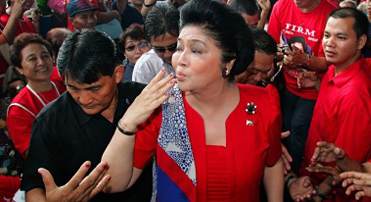
I love you ... with a little salt ...
Now, the first thing I thought, as I spat out my coffee and pushed my breakfast away, was: "Whoa -- am I on this list?" And the second thing was: "So that's how she got that little weight problem."
But then another, almost insidious thought crept in. Probably this was just another weird episode in the whole bizarre Marcos saga. But maybe -- just maybe -- Imelda was really onto something here, something that could change all our lives. Had she, in her search for justice, actually hit on a major new snack concept?
I mean, think about it. All she has to do is convince the International Court that everyone who had ever "libeled" her should fry 'til they're crispy, and there would be a virtually unlimited supply of ... of ...
Well, I'm not sure what, exactly. But certainly somebody could package the result, think up a catchy name ("Imeldoes", maybe?) and dream up an advertising slogan. Something along the lines of: "Imeldoes -- Buy Them, or Be Them."
They'd come in different flavors, obviously. Filipino, of course, but Imelda also sounds ready to toast up a few Americans, too. A Hawaiian jury just ordered her to hand over $22 billion to a bunch of fortune hunters, so presumably there would be "Aloha Imeldoes" with a tangy pineapple flavor. Since it was pesky Swiss bankers who froze some of her assets, there would undoubtedly be Imeldoes with holes in them and sort of a cheesey flavor. And so on -- you get the idea.
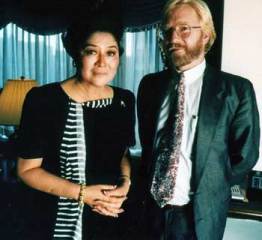
My date with Imelda Photo: Rick Kozak The worrying thing, of course, is that Imeldoes might really catch on. And what happens if, in the dog-eat-dog world of marketing, consumers start demanding Mexican or Chinese-style Imeldoes? Will the Marcoses have to take whole new ethnic groups to court?
Inevitably, other politicians would get the same idea and jump on the bandwagon. How soon do you supose it would be before Aung San Suu Kyi, for example, was trying to get "Slorkies" onto supermarket shelves?
Now, probably none of this is going to happen. Imelda was just in a bit of a snit. And admit it -- wouldn't you be cranky if you lost a $22 billion court case?
So I don't really blame her for heating up the frying pan. Imelda is given to extremes, as we all know from examining her bra collection. But apocalyptic cooking fantasies need to be taken seriously when they're voiced by seriously rich people, and Imelda does have a rather broad grocery list.
And what worries me is that I may be on it, the result of a not-so-flattering magazine story I wrote about her a few years ago. I had spent three hours interviewing her at the Madison Hotel in Washington, DC, and while she was extremely pleasant to me, it was pretty clear that her neurons were badly misfiring. She cried quite a bit, and rambled on vaguely about about God, buried treasure and vox populi. There was a photographer with me, and Imelda made a joke, sort of. "Ferdinand used to say the photographers were the real dictators," she said, and giggled to herself for a while.
Then, at the end of the interview, she invited me to come dine with her "when I'm back in Malacanang Palace." I accepted, of course. Simple politeness.
But now, I suppose, you'd have to answer that invitation with: "Umm, I think so -- who's on the menu?"
Notes from Underground
By Stephen Brookes in Yangon • Asia Times
______________________________________________________________________________________
The girls all thought it was pretty funny when the guy in the Happy World hat picked a bone out of the grave and pretended to chew on it. "Grrrr," he said, offering it to one of the female workers, who shrieked and jumped away. He reached into the grave again and pulled out a skull; it was reddish brown, and still had a few teeth in it. He sat it on his shoulder and leered at me. "Gaung kun," he said; the head bone.
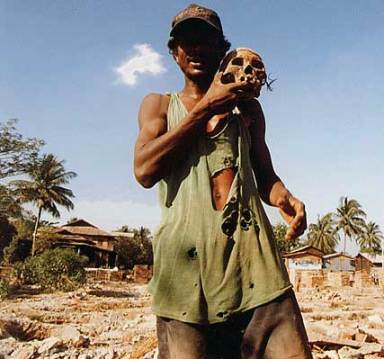
Stephen BrookesWe were sitting in the middle of the Kyandaw Cemetery in Yangon, and things were getting strange. A hundred yards in every direction spread a sea of open graves, and in the distance small groups of men were breaking into coffins and tossing the bones into black plastic garbage bags. Nearby, women were pulling bricks up from the tombs, knocking off the dirt and carrying them away. It was hot and dusty, and there was an indescribable smell; not bad, exactly, just strange and unnerving, and oddly narcotic. You wanted to lie down and go to sleep.
Kyandaw is a huge cemetery, about 70 acres sprawling through one of the fastest-developing parts of Yangon. It's a hot topic of conversation right now, because the whole place is being dug up and converted to commercial use -- although no one knows what, exactly. The Yangon City Development Committee, which decides these things, told relatives back in November to move the remains to another cemetery, but that's all. So there's been the usual run of Khun Sa rumors. Everyone's heard that the former drug lord is putting up a shopping center on the site, or possibly an office complex, or possibly the world's biggest miniature golf course. But everyone in Yangon hears fifteen Khun Sa rumors a day, and no one believes any of them anymore.
So I went down to have a look, as much out of morbid curiosity as anything else. Kyandaw had come up at a dinner party a few nights before, when one of the guests pointed out a supernatural problem with this kind of urban renewal.
"Two years ago, they moved a food market onto the site of an old cemetery," she said. "But now hardly anyone goes there, because they're spooked. And if you buy beef there, you bring it home disguised with a piece of charcoal -- because everybody knows that ghosts like beef."
I stepped slowly along a path through the graves. Most of them had been completely dug up, and some primal instinct made you look into each one as you passed, even though there was nothing to see. Bits of white ribbon, dead weeds, broken pieces of brick.
In other areas, the coffin-shaped tombs had been left intact, but holes had been dug under them to remove the remains. Across one of them, someone had scrawled a checkerboard in yellow chalk. On the ground nearby, a broken marble tombstone read: "In loving memory of our baby John Koop, born and died on July 10, 1949." Brillant yellow butterflies flickered in the air.
The path took me to a small, low shed at the north edge of the cemetery. I passed the front door and looked in: Two shapes moving around in the gloom. Outside was a jumbled pile of dusty black plastic bags, each one sitting on a marble tombstone. I walked over and looked. "In Loving Memory, Daw Grace Sein. Asleep in Jesus, Age 74 Years. Thy Will be Done." The sack was tied with a small piece of plastic ribbon, with a cardboard tag. There were hundreds of them on all sides of the shack, and one had broken open and spilled the bones onto a headstone. "Of All the Gifts," I read, "Love is Still the Best."
Just then, one of the shapes came out of the shed and started shouting angrily at me, pointing to the gate of the cemetery. I made calming explanatory sounds, pointing in the opposite direction. We stared at each other for a minute, when suddenly a kid on a white horse came riding up. He was only about twelve, but he spoke quickly and with great authority to the man, then rode away. The man went back into the shed.
It felt more and more like I'd walked into some strange, disturbing dream. I followed the path the kid on the horse had taken, through a gate marked with a death's head drawn in charcoal. It led to a dusty lane toward Hanthawaddy Junction, where I'd left my car. But the path took me through another part of the cemetery, where more graves were being dug up. It was very quiet, with the sound of hammering in the distance. I passed an old monk, who was standing next to an open grave and staring fiercely into the distance. I passed in front of him. He didn't even see me.
Then I noticed I'd picked up a tail; a small, tough-looking guy in a tee-shirt with the arms torn off. He wasn't hard to spot; he was suddenly at my elbow, urgent and out of breath. When I looked at him, he didn't look back -- he just pointed toward the exit. He had serious tattoos running up and down both arms. There was no discussion.
So we turned and started across a clearing, and the dirt turned black. I looked down and saw that we were walking over ashes, then noticed the stray bits of charred bone. The crunching under my feet suddenly felt grotesque and disgusting. The tail pointed down another path, and as we passed through a grove of trees we came across another clearing where three men were building a tiny coffin, maybe a meter long. A dozen more of the things were stacked up nearby, and a woman was sitting cross-legged on a bench tying white ribbon into bows. She glanced up, saw the guy with the tattoos, looked away. I recognized the white ribbon -- it was the same stuff I'd seen in the empty graves. We got to the gate, and he pulled a barbed wire barrier aside. In the street, people were going about their lives. I walked back to my car.
The next weekend, the government held its monthly press conference. There was the usual discussion of political and economic issues, and we were starting to run out of questions. So I asked if they could fill us in on the cemetery renovation, and got a curt, "no comment" in response. A correspondent from Voice of America was sitting next to me, and he leaned over. "In other words," he muttered under his breath, "it's a dead issue."
Lights! Camera! Neo-colonialists!
By Stephen Brookes in Mandalay
for Asia Times
The scene: The outskirts of Mandalay Palace, dusk. A tall figure in Burmese court dress appears from behind a wall and rushes down a flight of steps, where a British military officer is standing with his troops.
"Captain, Captain!" he shouts. "I have met a Burmese prince and his followers! They are very dangerous -- they will do anything to get the throne!"
"Where are these people?" demands the captain.
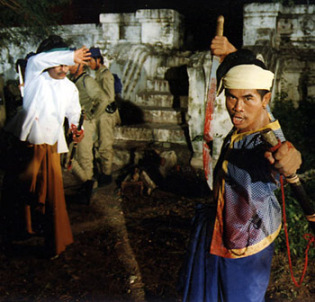
Stephen Brookes "I have shown the sergeant here the place," says the tall man, patting another soldier on the chest. "I think that if we get 20 soldiers, it will be quite enough. And Captain!" he calls, as the British officer starts to move off. "When you see Colonel Sladen, tell him: Do not forget Maung Tha Pyo! Do not forget Maung Tha Pyo!"
"Cut!" shouts the director, and the actor playing Maung Tha Pyo -- a minor traitor in the fall of Mandalay to the British in 1885 -- slumps into a chair and lights a Marlboro, looking irritated. The director's assistant, script in hand and a cell phone tucked in the belt of his camouflage pants, barks instructions to the extras, and the cameraman repositions the tripod-mounted Arriflex for the next scene. It's a little after six o'clock and the actors are ready to quit for the day, but there's still one crucial scene to be finished.
"This is a very important film, and we have to make sure all the historical details are precise," said Tekatho Hpone Naing, watching the action from his chair under a huge tamarind tree near the palace wall. A courtly man in his late 70's, Tekatho Hpone Naing is deeply interested in this movie, and the crew treats him with deference: Not only is he Myanmar's most famous writer, he's also the author of the novel they're filming.
Titled "Thu Kyun M' Khan Byi" -- We Shall Not Be Enslaved -- the movie is an account of Britain's rapid conquest and annexation of Upper Myanmar in the final days of November 1885, when King Thibaw and his queen Supayalat were dethroned and sent into exile. It was a traumatic moment in the country's history, as Myanmar -- then known as Burma -- came under British rule for the next six decades. And it happened, historians agree, because Thibaw's weak and faction-ridden government was unable to fend off Britain and France as the two great imperial powers fought for supremacy in South East Asia.
"I wrote this novel to warn my people not to repeat the tragedy again," said the elderly author, as a crowd of extras in turbans and khaki uniforms filed past. "But I blame no one, including the British. What happened was that an advanced, industrial civilization met an isolated one, and we lost. So with this novel, I tried to warn my people: Be modern. Be international. Open your eyes, and open your hearts."
Despite going through ten editions since it was written in 1958, this is the first time that the book is being filmed -- and no expense is being spared. The director, cinematographer and all the key players are winners of Myanmar's Academy Awards, and thousands of extras are being used in the epic scenes. "This is the most important film ever made in Myanmar," said Chit Oo Nyo, the film's screenwriter, as he watched the rehearsal from the sidelines. "I'm a little nervous."
But even as Myanmar's historic defeat is being brought to the big screen, the threat of domination by "neo-colonialists" is a daily theme in the state-run press. That very morning, Lt-Gen Khin Nyunt, one of the country's top leaders, had urged the nation to "crush" anyone spreading foreign ideas, explaining: "Colonialism of old times had its way of unjustifiably transgressing, making war and occupying another country. Neo-colonialism today has its way of breeding their cohorts in a country they want to get under their influence and try to dominate it with their cultural ways."
Is that why this movie is being made now -- as anti-foreign propaganda?
"Absolutely not," insisted screenwriter Chit Oo Nyo. "The most important thing we want to say is that inner unity is more important than external influences. It doesn't matter about imperialism -- with unity in the country, we will never be lost."
As he spoke, the sky had grown dark and hundreds of spectators had gathered in the surrounding meadow to watch the spectacle. It was an eclectic crowd: schoolchildren, old men on bicycles, mothers holding babies, soldiers from the military compound that occupies a large part of the palace grounds. The air was thick with hundreds of tiny white moths fluttering in the 4,000-watt stage lights, and an unkempt man with a wild beard sat cross-legged in the grass, mewing like a cat, as children threw bits of grass at him. Occasionally a brightly-dressed actress would appear out of the shadows, glitter for a moment, and disappear again into the dark.
From his seat under the tamarind tree, the old novelist surveyed the scene intently.
"This is an historical tragedy, but people rarely understand the meaning of history," he said quietly. "In 1970, the Russians translated my book, but they didn't comprehend it at all. They called it 'a novel of national liberation.' But that's just communist jargon -- pointing to outsiders, capitalists and imperialists, but never toward oneself." He paused, looking over the crowd. "One has to examine oneself, in order to understand history."
As he talked, a technician nearby was taping a small explosive device to the stomach of one of the actors, preparing for the final scene of the day. It was to be a complicated death scene, and the crew was working out the intricate special effects of bloodletting. The director rushed back and forth among the characters, fretting over the details and checking the costumes, making everything real.
Finally, the scene was set. The director motioned with his hand, and an aide passed a bottle of stage blood to the traitorous Maung Tha Pyo, who took a swig and held it in his mouth, grimacing at the taste. The cameras began to whirr, the clapboard clapped, and Maung Tha Pyo stood alone in the harsh light.
Out of nowhere, a fighter loyal to King Thibaw burst onto the scene and charged the traitor with a cry, thrusting a long wooden sword between his arm and torso. The hidden blood bags burst and Maung Tha Pyo, mortally wounded, coughed up his mouthful of blood and fell to the ground with a groan. The killer raised his bloody sword in triumph -- but suddenly a British soldier appeared behind him, aimed his musket and shot him in the back.
The effect was electrifying, as the musket exploded and blood burst from the belly of the swordsman, spreading quickly across his shirt. "Run! We have been betrayed!" he shouted to his comrades, as he sank slowly to his knees and pitched over dramatically into the dust.
The rest, as they say, is history. There was silence for a moment, then Maung Tha Pyo picked himself up, spat the last of the fake blood out of his mouth and lit another cigarette. His killer unhooked the special effects device from his waist and traded jokes with the technicians, as the cast of traitors, heros, courtiers and conquerers -- their work done for the day -- shunted off their costumes and returned to real life.
Leaving only the question: What is real life in Myanmar?


